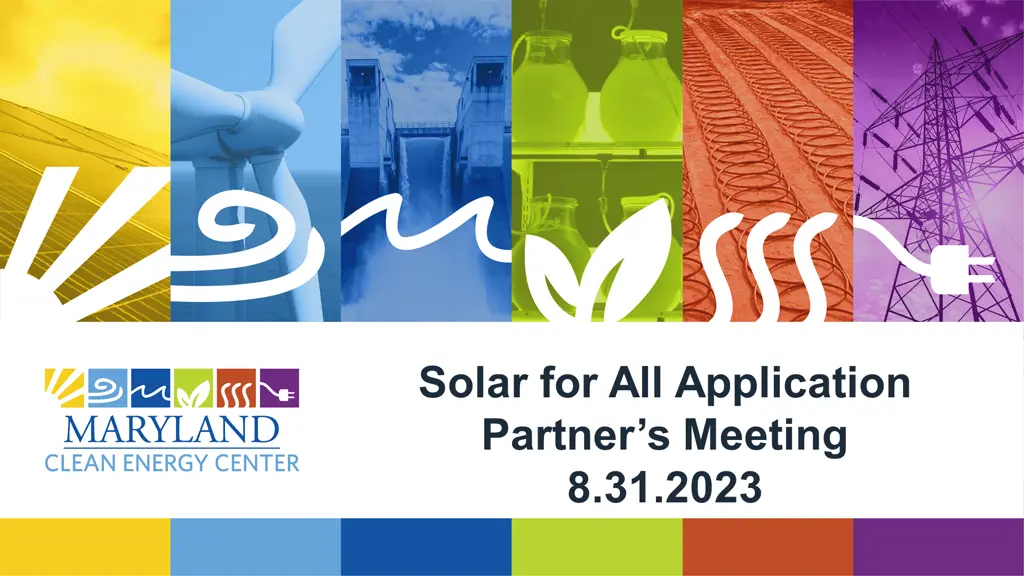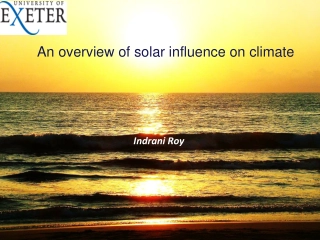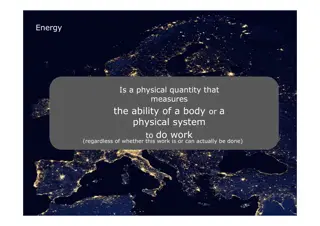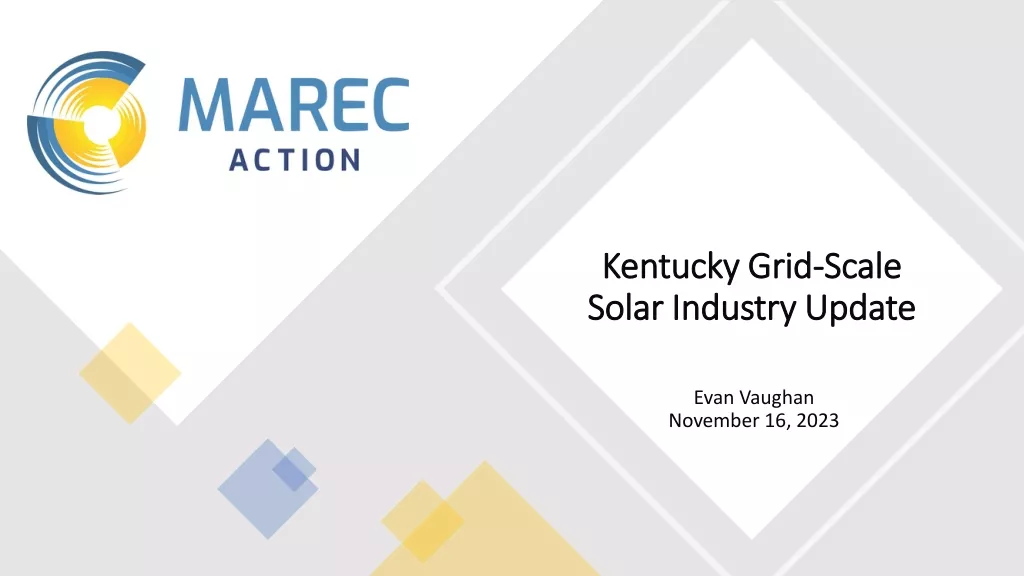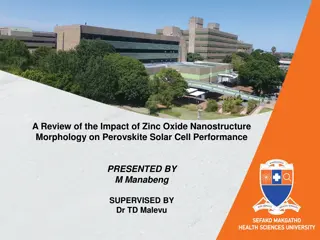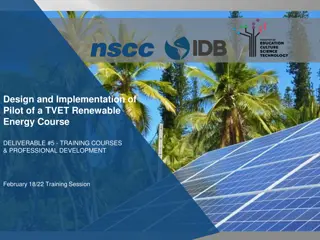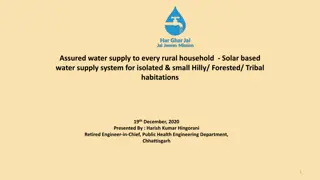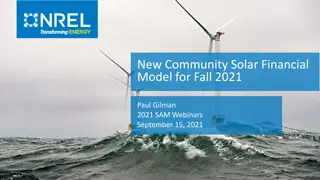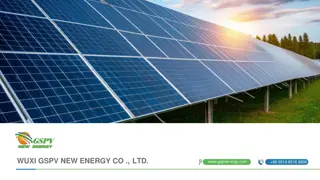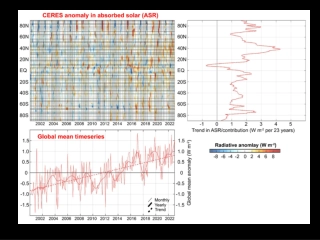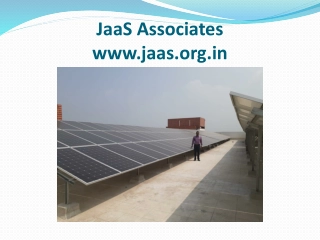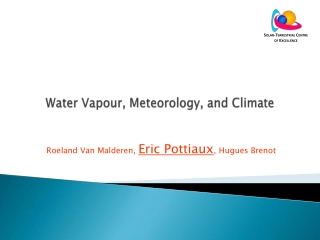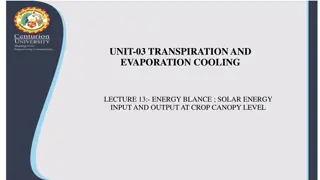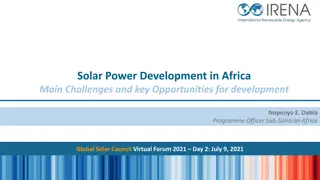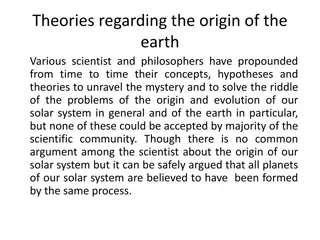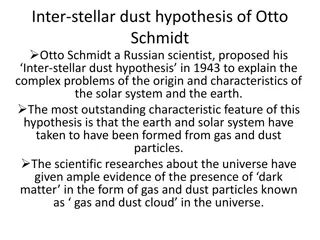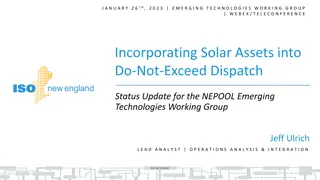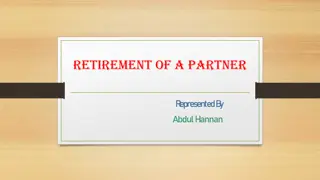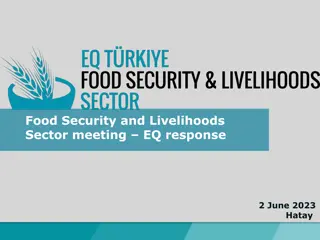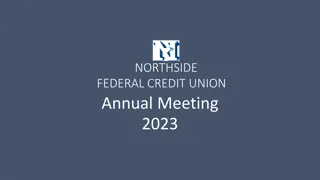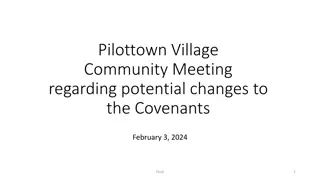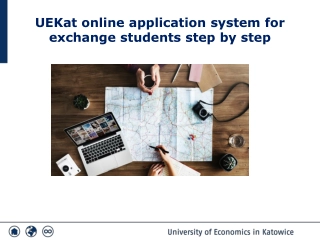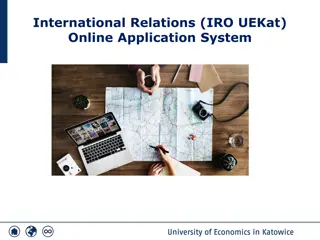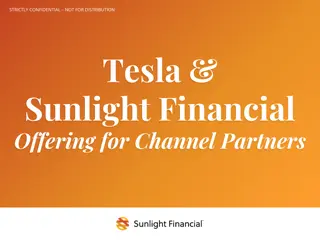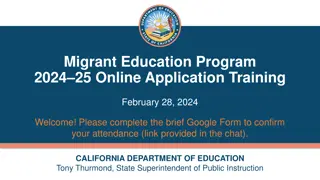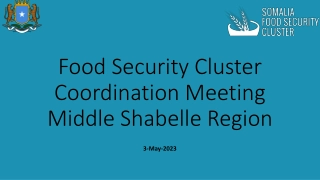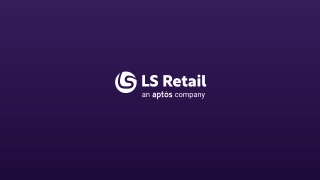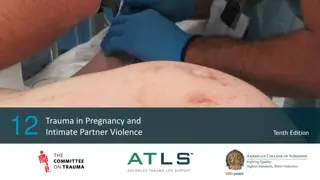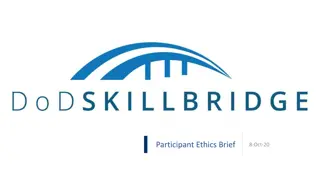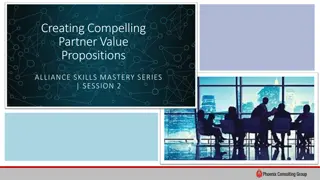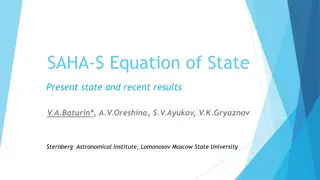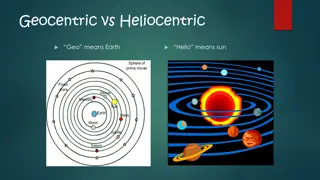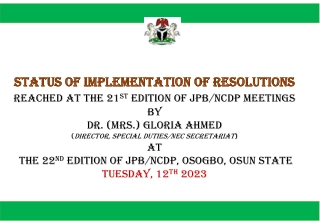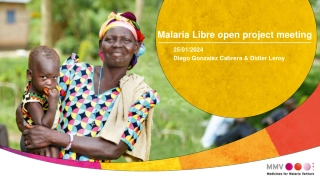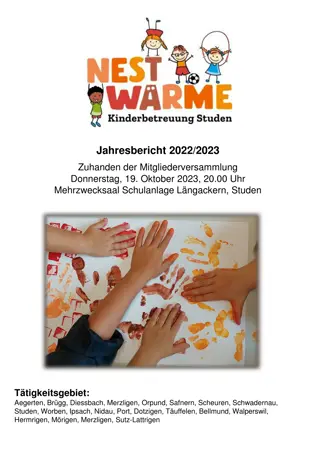Solar for All Application Partner’s Meeting
Join us for the Solar for All Application Partner's meeting on 8/31/2023. The agenda includes partner breakdowns, application strategy, funding, and more.
- application partner
- meeting
- agenda
- statewide initiative
- program funding
- financing strategy
- coalition partners
Download Presentation

Please find below an Image/Link to download the presentation.
The content on the website is provided AS IS for your information and personal use only. It may not be sold, licensed, or shared on other websites without obtaining consent from the author. Download presentation by click this link. If you encounter any issues during the download, it is possible that the publisher has removed the file from their server.
E N D
Presentation Transcript
Solar for All Application Partner s Meeting 8.31.2023
Agenda I. Welcome II. Partner Break Downs by Category, MOAs and LOSs Received III. Statewide Initiative Program/Application Strategy IV. Application Point Review by Category V. Data Charts VI. Program Funding and Financing Strategy VII.Adjourn 2
Welcome Back 8/31/2023 3
Coalition Partners to Date Organization Name Name Last CO PTR? MOA? SUB RCP?? LOS? ORG TYPE COALITION PARTNERS Maryland Energy Administration Eric Coffman Y N N N SG Maryland Department of the Environment Allison Tjaden Y N N N SG Maryland Department of Labor Logan Dean Maybe N Maybe N SG NAACP Abre Connor Y N Maybe N CBO CHESSA Matthew Katz Y N Maybe N NGO City of Annapolis Jackie Guild Y Y Maybe Y LG Howard County, MD Leah Miller Y Y Maybe N LG Frederick County, Maryland Kristin Mielcarek Maybe Y Maybe N LG Montgomery County, MD Lindsey Shaw Maybe N N N LG Baltimore County Seth Blumen Y Y N N LG Charles County Beth Groth Y Y N N LG City of Rockville Erica Shingara Maybe N Maybe N LG Enterprise Community Development John Fox Y N Maybe N NGO Garrett County Community Action Committee Duane Yoder Y Y N Y CBO National Housing Trust Raymond Nevo Y N Maybe N NGO 4
Subrecipients to Date ORG TYPE Organization Name Name Last CO PTR? MOA? SUB RCP?? LOS? COALITION PARTNERS & SUB RECIPIENTS Department of Housing and Community Development (DHCD) Climate Action Fund Nicola Lynn Tran Heller Y Y N N Maybe Y N N SG NGO Green Bank NGO NGO NGO Other CBO CBO NGO CBO CBO CBO CBO CBO Montgomery County Green Bank GRID Alternatives GRID Alternatives-Mid-Atlantic Power52 Foundation WorkSource Montgomery Black Wall Street Groundswell International Center for Appropriate and Sustainable Technology (ICAST) Civic Works Building Change Solar United Neighbors Huntington City Community Development Corporation (HCCDC) Community Action Council of Howard County Stephen Andie Elijah Cherie Jessica Dr. Masica Jordan Alston Y David Wright Ryan Kristoff Eli Allen James Miletello Shelby Fletcher Darrell Carrington Gary Christopher Morel Wyatt Perry Brooks Issoufou Y Y Y Y Maybe N/A N N Y N Y N N Y Y N N Y Maybe Y Y Y Maybe Y Y Y Y Y Y Y Y N N N Y N N N N Y N N N Y Y Y Y Y Y Y Y 5
Capital Providers to Date Organization Name Name Last CO PTR? MOA? SUB RCP?? LOS? ORG TYPE CAPITAL PROVIDERS Climate First Bank Marcio deOliveira Y N/A N Y Other SolAAr Investment Group Angela Lewis Y N/A Y N Small Business 6
Technical Assistance to Date Organization Name Name Last CO PTR? MOA? SUB RCP?? LOS? ORG TYPE Technical Assistance Center for Climate Strategies (CCS) Thomas Peterson Y N/A Y Y NGO Pepco Holdings, Inc. Lushae Cook Maybe N/A N N Utility BGE Ethan Holmes Y N/A N N Utility 7
Contractors Requests to Date Name Last Phone Number CO PTR? MOA? SUB RCP?? LOS? ORG TYPE Organization Name For-Profit Contractors Remesh Sartani Y N/A Y N Small Business Decarbonize Building Systems 703-624-1079 Native Eagle Consulting Group LLC Raymond Wicks 410-670-1780 N N/A N N Small Business InClime, Inc Michael MacMillan 252-202-9128 N N/A N N Small Business Urban Clean Energy Advisor Kimberly Armstrong 443-233-3006 Y N/A Y N Small Business 28 Walker Development Alex Mandel 410-653-4600 Maybe N/A Maybe N Small Business RIFE International, LLC Kwabena Osei-Sarpong 240-389-4187 Y N/A Maybe N Small Business RoofexNRG.com Sonny Choudhury 202-191-4091 N N/A N N Small Business Precision Exteriors Nathan Whitaker 443-280-2636 N N/A N N Small Business Clean Slate Solar Sho Arora 917-331-6616 N N/A N N Small Business FCONTRACTS Frederick Johnson 202-528-0934 N N/A N N Small Business EDGE Energy Jason Dispenza 703-220-5868 N N/A N N Small Business Energy By Nature Technology, LLC Thomas Quattlebaum 240-320-4544 N N/A N N Small Business Unified Services and Consulting Will Epps 410-963-2567 N N/A N N Small Business TurningPoint Energy Joe Rosenberg 415-272-8311 N N/A N N Commercial Energy Select LLC James Horstkamp 301-904-5928 N N/A N N Small Business Chaberton Energy Erica Brinker 412-715-3652 N N/A N N Commercial UtilityAPI Mike Burke 518-928-2288 N N/A N N Other CleanCapital Scott Elias 516-286-6473 Maybe N/A N N Other Lumeco Energy Damola Ademiluyi 443-278-3513 N N/A N N Small Business Pure Solar Systems Gregory Floyd 240-305-2932 N N/A N N Small Business Apexx Adams Transportation & Clean Energy Solutions Felicity Flucas 240-636-7381 N N/A N N Small Business Black Willow - MBE Kaitlyn Burgess 443-254-7056 N N/A N N Small Business Citizen Energy, LLC Edwin Luevanos 202-499-1595 N N/A N N Small Business ProsumerGrid Susan Glickman 727-742-9003 N N/A N N Small Business Sol-REIT, LLC Derek Gabriel 202-270-0603 Y N/A Y N Solar Project Financing Im Still Standing Community Corp Lawanna Perkins 443-540-8255 Y N/A Y N Small Business, Community Organization, Workforce Development Neighborhood Sun Cara Humphrey 914-475-1395 Y N/A Y N Small Business/Benefit Corp 8 Allectrify, PBC Colin Bishopp 202-55-07570 Y N/A N N Small Business MoCo Green Futures Samuel Suraphel 571-970-7537 Maybe N/A Y N Small Business
Statewide Initiative Program/Application Strategy Narrative Points (245 Total) 9
Program Strategy Narrative: (175 points total) Impact Assessment Section: (20 points) Align Project GGRF Solar for All Program Objectives: 1. Reduce emissions of greenhouse gases and other air pollutants 2. Deliver benefits of greenhouse gas-and air pollution-reducing projects to American communities, particularly low-income and disadvantaged communities 3. Mobilize financing and private capital to stimulate additional deployment of greenhouse gas- and air pollution-reducing projects 10
Impact Assessment Section: (20 points) List all Coalition Members and their roles Outline Scope of Work Set reasonable and ambitious targets for program outputs and outcome metrics Show how the proposed outcome metrics are reasonably achievable considering historical data (either past deployment of low-income distributed solar and storage in the geography the applicant is applying to serve or based on deployment in geographies with similar conditions) Describe the market environment for residential-serving distributed solar and storage deployment in the geography you are applying to serve, including market-wide historical deployment rates and participation of low-income and disadvantaged households and communities in the market Based on past deployment rates, you should set reasonable output and outcomes targets for capacity of solar and storage deployed, households served, projected annual carbon dioxide (CO2) emissions avoided (in short tons) Use AVERT, annual household savings realized, additional output and outcomes metrics 11
Meaningful Benefits Plan: (30 points) 1. Household Savings delivering a minimum of 20% household savings to program beneficiaries defined as 20% of the average household electricity bill in the utility territory. Appendix C Household Saving Guidance 2. Equitable Access to Solar ensuring the program increases low-income and disadvantaged households access to solar through financing products and project-deployment technical assistance 3. Resilience Benefits Increasing the resiliency of the power grid by creating capacity that can deliver power to low-income and disadvantaged households and/or critical facilities serving low-income and disadvantaged households during a grid outage 4. Community Ownership Facilitating ownership models that allow for low-income households and communities building equity in projects and to access the additional economic benefits of asset ownership 5. Workforce Development and Entrepreneurship Investing in high-quality jobs and businesses in low-income and disadvantaged communities by supporting prevailing wages, investing in effective workforce training programs for underserved populations (pre-apprenticeship and registered apprenticeship programs) and prioritizing equitable economic opportunities for women and minority-owned businesses and contractors 12
Distributed Solar Market Strategy: (30 points) Describe the market barriers to residential-serving distributed solar deployment in the geography you are applying to serve How you plan to address those barriers to enable low-income and disadvantaged communities to deploy and benefit from residential rooftop and residential-serving community solar and storage Letters from public utilities should indicate that the proposed distributed solar market strategy is achievable. Market structures & policies: a. b. Third party ownership c. Renewable portfolio standards (RPS mandates) d. Structural barriers e. Work with relevant market stakeholders utilities, public utility commissions & jurisdictional entities to address barriers Net metering, including net metering caps 13
Financial Assistance Strategy: (30 points) How will you use Solar for All funds to provide eligible financial assistance (subgrants, rebates, subsidies, other incentive payments, debt (including loans, partially forgivable loans, forgivable loans, soft loans, subordinate debt), to enable low-income and disadvantaged communities to deploy and benefit from residential rooftop and residential-serving community solar and storage? Include type, size and deployment strategy of financial assistance. Specify which solar projects the program will provide financial assistance for (anticipated share of funding for each project type). Detail if and how the program will financially support storage (including storage deployment targets) and prudently provide financial assistance for enabling upgrades while maximizing solar deployment. Define plan and upgrade definition. Describe how the program will complement, and not duplicate, existing subsidies, tax credits, and other sources of financing and support deployment that would not have occurred otherwise. Describe plan that considers long-term impacts of program financial assistance. Quality and extent of plan to support operations, maintenance and recycling of the assets including maximum energy output of the assets and conducting audits of assets to ensure operations and maintenance is performed. 14
Project-Deployment Technical Assistance Strategy: (20 points) How will you support communities and other solar market stakeholders (solar developers, contractors, affordable housing developers, owners) with technical assistance to develop project pipeline and deploy solar? Project-deployment technical assistance services should include investments in workforce development, project deployment technical assistance (siting, permitting, interconnection), and other technical assistance. Consider what project-deployment technical assistance services are already provided by federal, non-profit, and other market actors to minimize duplication and plan to leverage existing resources. Demonstrate a plan for developing the necessary workforce to install solar in the geography you propose to serve. Training plans should articulate how participants will be trained for and placed in high-quality careers. Propose workforce training models that prepare individuals from low-income and disadvantaged communities for middle-class career pathways in partnership with workforce partners Appendix E. 15
Project-Deployment Technical Assistance Strategy: (20 points) Must have one or more registered apprenticeship programs and pre-apprenticeship (apprenticeship readiness) programs affiliated with Registered Apprenticeship programs, Labor-Management Training Partnerships, local community college or Minority Serving Institutions. Including wrap around services and supportive services transportation, childcare, case management and on-the-job support and mentorship. Include letters of support from DOL, Workforce Investment Boards. Describe plan to ensure that projects are efficiently deployed and resilient, provide technical assistance on project siting, land-use, permitting, building codes, inspection and quality control. Engage with utilities on project siting, leveraging community benefits agreements, considering land use planning and zoning requirements that impact siting strategy; climate hazards (flood zones), wetlands, and productive farmland, adopting Agrivoltaics in siting strategy if relevant, using remediated brownfields for project siting, managing permitting process and challenges and adopting existing technical assistance tools such as DOE s DOE/NREL s, SolarAPP+ and SolSmart. 16
Equitable Access and Meaningful Involvement Plan: (30 points) Describe how your customer acquisition strategy will maximize solar deployment across the geography you will serve, ensuring equitable access to and participation in the program-- equitable access means all communities, especially historically underserved households and communities. Explain how you will educate and engage communities on the benefits of solar energy. Describe how your outreach and marketing strategies are culturally appropriate and responsive to the needs of the communities you are proposing to serve. You should consider how you may need employ different engagement strategies to reach different types of communities, including urban, rural, and suburban communities; communities with limited English proficiency; and different types of residential buildings, including single-family, multi-family, and manufactured homes. To ensure equitable access, you should describe how low-income and disadvantaged communities will be involved in program design and operations. 17
Equitable Access and Meaningful Involvement Plan: (30 points) Describe how communities can participate in program and project design, in formal input and feedback structures include participatory governance and regular, meaningful engagement with community-based organizations and residents of low-income and disadvantaged communities. If you have Native American communities in your geography, you should describe how the program will serve these communities and meaningfully involve these communities in program planning and operations. Create participatory governance formalized structures for communities to be involved in the design and decision-making of the program. To reduce fraud and waste, the application will be evaluated on the extent and quality to which the program plans to perform robust income verification above and beyond attestation. 18
Program Planning Timeline and Workplan Narrative: (15 points) How you will plan and implement the Soar for All program including steps and milestones to implement the strategies and plans described in the Meaningful Benefits Plan, Distributed Soar Market Strategy, Financial Assistance Strategy, Project-Deployment Technical Assistance and the Equitable Access and Meaningful Involvement Plan. The plan may also include steps to refine the program during a planning period if including a planning period you should consider existing federal, academic and philanthropic platforms, tools and resources you may plan to leverage to support program planning and any partnerships you have established or plan to establish to support program planning and implementation. A timely plan will ensure that the planning periods is at most one year and that the program spends all funds within five years of the award. Show quality and extent of plan to dedicate planning capacity to incorporate forthcoming EPA guidance on how and when to apply Build America, Buy America and Davis-Bacon prevailing wage requirements Commit to adopting residential rooftop and residential-serving community solar best practices by planning to leverage existing technical assistance tools and resources for program planning. 19
Program Administration Narrative: (50 points total) Budget Narrative: (15 points) o o Provide a narrative to describe the budget found in SF424A and the Budget Table Attachment E. Describe how you will deploy funds efficiently and cost-effectively and explain how the costs are prudent and necessary to achieve the outcomes of the program Separate out costs direct/indirect o Fiscal Stewardship Plan: (20 points) o You should have comprehensive policies and procedures to ensure robust risk management across your activities; prevent fraud, waste and abuse; and prudently manage grant funds Explain plan for consumer protection, including how you will ensure program partners and entities that directly interact, transact, or contract with consumers as part of the program will comply with applicable consumer protection laws in the jurisdictions your program will serve, and federal consumer protection and consumer financial laws. Explanation should include descriptions of practices you plan to use for effective consumer protection in your program and processes for screening entities that will directly interact, transact, or contract with consumers in your program. Appendix D. If you are proposing to capitalize a revolving loan fund, you should describe the financial management plan for program income in the fiscal stewardship plan. Policies for program oversight, confidential reporting (whistleblower protections), conflict of interest Consumer protections and combat predatory lending practices Perform audits and spot checks of bills o o o o o o 20
Program Administration Narrative: (50 points total) Reporting Plan: (15 points) o Have a plan to integrate program evaluation activities into the reporting plan, including assessing effectiveness and efficiency in achieving outputs and outcomes. o Evaluations should follow EPA Order 1000.33 o Invests program capacity in performing program evidence and evaluation activities and details a plan to publish date, evidence, and evaluation reports publicly during the program lifetime o Demonstrates an understanding of the award reporting requirements, a plan to execute on the reporting requirements and the capacity to execute on those reporting requirements 21
Programmatic Capability and Environmental Results Past Performance: (20 points) o Submit a list of federally and/or non-federally funded assistance agreements that the organization has performed in the last three years. o Answer whether and how you were able to successfully complete and manage those agreements. o Your history of meeting the reporting requirements under those agreements including whether you adequately and timely reported on your progress towards achieving the expected outputs and outcomes of those agreements (if not, why) and whether you submitted acceptable final technical reports under the agreements. o Your organizational experience and plan for timely and successfully achieving the objectives of the proposed project, and your staff expertise/qualifications, staff knowledge, and resources or the ability to obtain them, to successfully achieve the goals of the proposed project. o Indicate if you do not have any relevant or available past performance or past reporting information receive half the points, better than not answering, no points. 22
Housing TypeNumber of LI Households Housing Type No, of LI Households Single-family attached 102,258 22.83% Single-family detached 149,657 33.42% Apartment (2- to 4-unit building) 32,631 7.29% Apartment (5 or more unit building) 151,743 33.88% Mobile home 11,574 2.58% TOTAL 447,863 100.00% Housing Type - Number of LI Households Mobile Home 11,574 2.58% APT-5+ 151,743 33.88% SF-Attached 102,258 22.83% SF-Detached 149,657 33.42% APT-2-4 32,631 7.29% Single-family attached Single-family detached Apartment (2- to 4-unit building) Apartment (5 or more unit building) Mobile home 23
Total GrantFinancing & Funding vs. Tech/Admin Total Grant -Financing & Funding vs. Tech/Admin Monetary Percentage Financing & Funding $ 300,000,000.00 75% 25% Deploymentment-Technical Assistance - Administration $ 100,000,000.00 Grant Total $ 400,000,000.00 100.00% Total Grant -Financing & Funding vs. Tech/Admin Tech & Admin $100M 25% Funding & Financing $300M Financing & Funding Deploymentment-Technical Assistance - Administration 24
Overall Grant Funding Distribution by Market Sector (proposed) Financial Assistance Funding Monetary Percentage Financing & Funding $ 300,000,000.00 75% Single Family $ 75,000,000.00 25% Multi-Family $ 75,000,000.00 25% Community $ 60,000,000.00 20% Community Serving Solar $ 15,000,000.00 5% Cummunity Serving Solar $15M 5% Single Family $75M 25% Community $60M 20% Multi-Family $75M 25% 25 Single Family Multi-Family Community Community Serving Solar
Enabling Upgrades 20% of Financing Funding Allowed ($60,000,000 Lifetime) Monetary Percentage Funding Allowance $ 60,000,000.00 Electrical System Upgrades $ 15,000,000.00 25% Structural Building Upgrades $ 15,000,000.00 25% Energy Efficiency $ 15,000,000.00 25% To Be Determinied $ 15,000,000.00 25% Enabling Upgrades Electrical System $15M 25% TBD $15M 25% Structural Building $15M 25% Energy Efficiency $15M 25% Electrical System Upgrades Structural Building Upgrades Energy Efficiency To Be Determinied 26
Deployment-Technical Assistance/Administration Up to $100,000,000 Total Monetary Percentage Funding Allowance $ 100,000,000.00 Workforce $ 35,000,000.00 35.00% Outreach & Education $ 15,000,000.00 15.00% Planning & Tech Assistance $ 30,000,000.00 30.00% Administration $ 20,000,000.00 20.00% Deployment - Technical Assistance - Admin Workforce $35M 35% Admin $20M 20% Planning & Tech Assistance $30M 35% Outreach & Ed $15M 15% 27 Workforce Outreach & Education Planning & Tech Assistance Administration
Community Benefit Organizations If you are planning on being a subrecipient of funding, please submit your 501(c)3 paperwork/IRS Letter to agillespie@mdcleanenergy.org 28
08/31/23 Program Funding and Financing Strategy SOLAR FOR ALL STRATEGIES/ BUDGET Financial Assistance Strategy Audience or Strategy Direct Lending Credit Subordination Agreements Equity Investments Tax Credits & Incentives GOV Investments & Incentives Note Grants Enhancements Overall SINGLE FAMILY RESIDENTIAL Owner Occupied Enabling Upgrades, Equipment & Installation MCEC / MCGB Y Y N Y Moderate Income Low Income Landlord Owned with Income Qualified Tennant Y Y 29
08/31/23 Program Funding and Financing Strategy Financial Audience or Strategy Assistance Strategy MULTI-FAMILY RESIDENTIAL Privately Owned System Sliding Scale Based on % of LI tenants and/ or tenant composition Subordination Agreements to reduce cost of capital with private lender partners and thru CPACE transactions Project feasibility study and design, enabling upgrades, equipment & installation Y -low cost captial and Bridge Loans to cover gap in tax credit availablity Y Y Publicly or NFP Owned System Sliding Scale Based on tenant composition Y Y Y Y 30
Program Funding and Financing Strategy Financial Assistance Strategy Audience or Strategy COMMUNITY SOLAR Privately Owned System Serving LI residential audience (40%?) Y Y-low cost Y Y M Y Publicly Owned Systems Serving LI residential audience (40%?) Y Y Y Y N Y COMMUNITY SERVING SOLAR Privately Owned Systems Serving defined eligible communities for resiliency For Profit and NFP Y Y Y N N M Publicly Owned Systems SG, LG or MG
Program Funding and Financing Strategy SOLAR FOR ALL STRATEGIES/ BUDGET Financial Assistance Strategy Audience or Strategy WORKFORCE DEVELOPMENT Y N N N Subsidized Fees N OUTREACH & EDUCATION Y N N N M N PLANNING & TECH ASSISTANCE Y N N N M N GHG Reduction M&V ADMIN Y N N N M N Grant Management & Compliance
Amy Gillespie Grant Administrator & Compliance Officer Phone: 301-314-6091 Email: agillespie@mdcleanenergy.org
